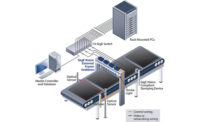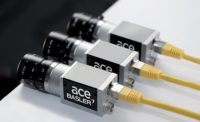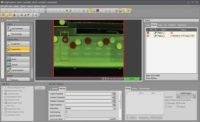Choosing the right video interface may mean the difference between success and failure for vision system designers.
Machine vision was born on the factory floor, and as technology has matured it is now automating tasks, guiding decisions, and improving outcomes across a widening range of applications and end-markets. However, as applications multiply and systems become more complex, designers face a growing set of challenges. Even as systems support increasingly detailed analysis, they must be intuitive and easier to use. Budget pressures often mean systems must deliver enhanced performance, without sacrificing investments in existing imaging equipment. Finally, systems must be simple and cost-effective to maintain and scale.
TECH TIPSThe industrial sector was among the first to recognize that machine vision could automate routine tasks and enable faster, more accurate quality inspection. Vision standards and a growing selection of compliant products are now making it easier for system designers to meet performance and cost challenges in established and emerging markets. Today GigE Vision is the most widely deployed video interface standard for industrial applications, and is gaining a strong foothold in the medical, defense and transportation markets. |
Considering these challenges, a key design decision is choosing the video interface— the technology used to transfer data from a camera or image sensor to a computer or display. Although the video interface is a small part of the overall vision system, it has a large impact on the usability, cost and scalability of the final product.
Vision Standards Simplify Design
To meet the needs of high-performance imaging applications, the video interface must transfer high-resolution video from cameras or image sensors to computers or displays in real-time, with high reliability and low, consistent latency (or delay). A bin-picking robot on a manufacturing line, for example, requires instantaneous transfer of imaging data from a camera to a processor to precisely locate and choose parts from a storage container. Within milliseconds, the vision system must detect an object, model it and the surrounding environment, accurately select the part, and then plan its next path.
Initially, video interfaces were often based on proprietary designs. These custom solutions met performance criteria, but were expensive to develop and maintain while introducing integration issues in multi-vendor systems. Existing telecom and broadcast standards, such as LVDS and HD-SDI, were also adapted for vision applications. Camera Link, introduced in 2000, was the first purpose-built standard for machine vision. As imaging systems perform more complex tasks, and end-users seek economical, easier-to-use solutions, the limitations of these standards become more apparent.
Each of these standards requires a dedicated connection between the image source and endpoint, whether that’s a computer for analysis or a display panel for observation. In applications where images are displayed across multiple screens, cabling becomes costly and complex. Moreover, these interfaces require a PCIe or PC card frame grabber at each endpoint to capture data. This limits the types of computers that can be used, drives up costs, and increases complexity. In addition, expensive switching is required to support real-time video networks.
Recognizing these limitations, camera manufacturers, component suppliers, and end-users joined forces to create a set of open, global standards to make it easier to install, upgrade, and maintain imaging systems and cameras. GigE Vision and USB3 Vision reduce design and deployment costs by enabling the transmission of full resolution uncompressed video with low, consistent latency over Ethernet or USB 3.0 cables.
As these standards gain wider adoption, an increasing number of video interface products are now available as off-the-shelf solutions. For retrofit projects, external frame grabbers make it straightforward to convert feeds from existing cameras into more manageable GigE Vision or USB3 Vision video. With embedded hardware solutions, manufacturers can easily integrate standards-compliant video connectivity directly into cameras and imaging systems.
GigE Vision and Industrial Automation
The GigE Vision standard, introduced in 2006, regulated video transfer and device control over GigE and was later expanded to encompass 10 GigE and wireless. With GigE Vision interfaces, imaging data is transmitted directly to the Ethernet port on a computing platform. There is no need for a PCIe frame grabber, which means any type of computer can be used, including laptops and tablets. Ethernet cables cost less, are simpler to install and maintain, and with their extended reach—up to 100 meters over standard copper cabling and thousands of meters over fiber—processing and image analysis equipment can be moved to more convenient locations for maintenance.
When first introduced, GigE Vision was valued primarily for its low cost and long reach in umbilical camera-to-computer connections. Today, designers are taking advantage of Ethernet’s inherent networking flexibility to build real-time switched video networks. GigE Vision brings a whole new dimension to applications, allowing one camera to send video to multiple endpoints, multiple cameras to send video to one endpoint, or combinations of the two.
GigE Vision-compliant products make it easier for designers to enhance reliability, future-proof designs, and extend the life of quality inspection systems designed around legacy analog or Camera Link interfaces. In web inspection (Diagram 1), external frame grabbers convert images from existing Camera Link Full cameras into a more flexible 10 GigE video stream. The uncompressed video is transmitted directly to ports on an image processing computer, eliminating the need for a computing platform with an available peripheral card slot. With longer reach Ethernet cabling, processing equipment can be moved from the harsh manufacturing environment to a centralized operations center.
The external frame grabbers support required point-to-point performance, with the networking flexibility to multicast imaging data to multiple computers simultaneously using an off-the-shelf Ethernet switch. This allows designers to optimize individual computers for different types of defects, rather than matching a PC to each camera. If a primary PC is taken offline for maintenance, inspection functions can be assumed by backup PCs without the need to switch cables or change software settings.
Ethernet is a mature technology that is globally installed across multiple industries and applications, meaning vision system designers can lower overall system costs by using off-the-shelf components developed, maintained and sold to the mass market by established providers. In addition, the widespread adoption of Ethernet encourages the continuing evolution of standards by suppliers and end-users. For the machine vision industry, this allows the reuse of technology already tested and perfected by other industries. For example, the IEEE 1588 protocol widely deployed over the past decade to synchronize wired and wireless telecom networks is used in machine vision systems to synchronize network devices with sub-microsecond accuracy over the same Ethernet connection used for image and control signals.
USB3 Makes the Simple Connection
While USB interfaces have been widely adopted in consumer and PC applications, the bandwidth supported by earlier versions of the standard was insufficient for vision applications requiring uncompressed, raw data for real-time image analysis. This changed with the USB 3.0 standard—or SuperSpeed USB—which provides 10 times the bandwidth of USB 2.0. Taking advantage of this raw speed and building on the concepts developed for GigE Vision, the machine vision industry standardized the transport of imaging and video data over a USB 3.0 cable with the release of USB3 Vision in February 2013.
With USB3 Vision, video and data is transmitted from cameras and sensors directly to existing ports on a computer, laptop or tablet over flexible USB 3.0 cabling. The USB 3.0 bus delivers sustained throughput approaching 3 Gb/s, surpassing the performance of Camera Link Base configurations and rivalling Medium configuration but without requiring multiple cables or specialized PCIe frame grabbers at endpoints to capture data. Beyond speed, USB 3.0 video interfaces deliver advantages to help lower costs, boost performance, and improve usability of vision systems.
In a bin-picking robot (Diagram 2), an external frame grabber converts the image feed from an existing Camera Link camera into USB3 Vision-compliant video. The uncompressed video—along with power and control—is transmitted with low, consistent latency over the USB 3.0 cable directly to existing ports on a computer used for analysis and display. The thinner, lighter USB 3.0 cable is more flexible to enable a wider range of motion for robotic applications, and easier routing allows faster setup and teardown of work cells for different products and short production runs.
A View Forward
The industrial sector was among the first to recognize that machine vision could automate routine tasks and enable faster, more accurate quality inspection to boost productivity and profit. Today, vision standards and a growing selection of compliant products are now making it easier for system designers to meet performance and cost challenges in established and emerging markets.
GigE Vision is the most widely deployed video interface standard for industrial applications, and is gaining a strong foothold in the medical, defense and transportation markets thanks to its ubiquitous platform support, multicasting, and interoperability capabilities. In its footsteps, USB 3.0 is fast-gaining approval across multiple markets, and as technologies continue to evolve could potentially become the video interface of choice for an even wider range of imaging applications.




